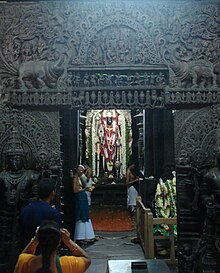

A garbhagriha (Sanskrit: गर्भगृह, romanized: Garbhagṛha) is the innermost sanctuary of Hindu and Jain temples, what may be called the "holy of holies" or "sanctum sanctorum".
The term garbhagriha (literally, "womb chamber") comes from the Sanskrit words garbha for womb and griha for house. Although the term is often associated with Hindu temples, it is also found in Jain and Buddhist temples.[1]
The garbhagriha is the location of the murti (sacred image) of the temple's primary deity. This might be a murti of Shiva, as the lingam, his consort the Goddess in her consecrated image or yoni symbol, Vishnu or his spouse, or some other god in symbol or image.[2] In the Rajarani temple in Bhubaneswar, near Puri, there is no symbol in that lightless garbhagriha.[3]
- ^ Sir Banister Fletcher's a History of Architecture, Edited by Dan Cruickshank (20th ed.). 1996. According to this edition of Sir Banister Fletcher's History of Architecture, the Jains consider themselves Hindus in a broad sense, and therefore the temple architecture of Jains in a given period and region is not fundamentally different from Hindu temple architecture, often being the work of the same architects and craftsmen, and even patronised by the same rulers.
- ^ Campbell, Joseph. Creative Mythology. p. 168.
- ^ Zimmer, Heinrich; Campbell, Joseph (1955). The Art of Indian Asia, Bollingen Series XXXIX. New York: Pantheon Books. p. Vol. II, Plates 336–43.